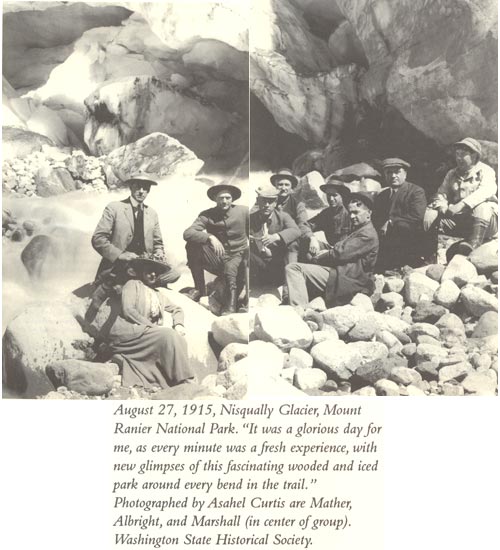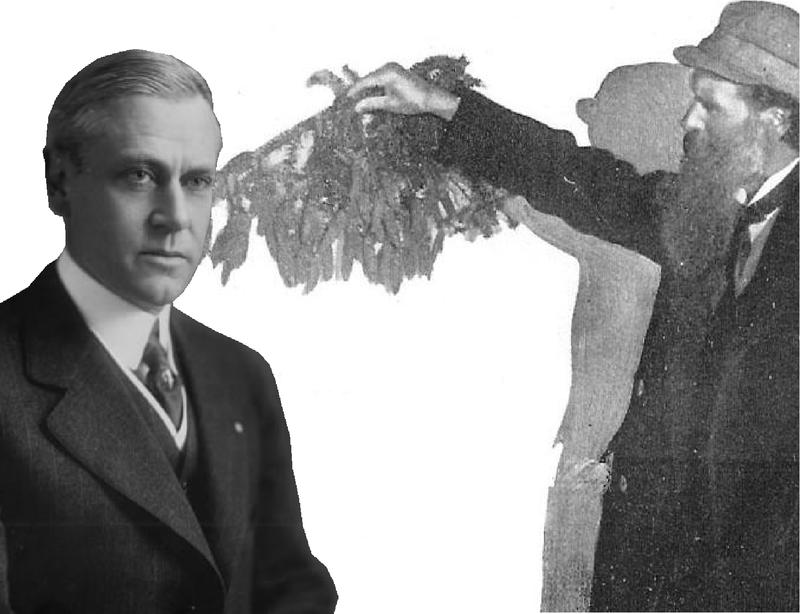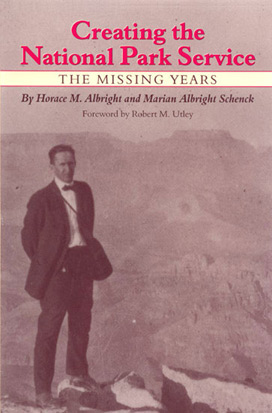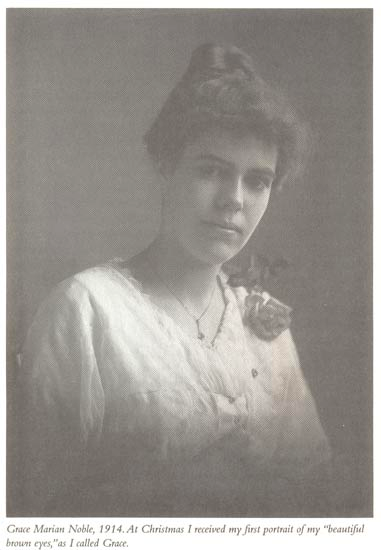We're committed to helping you
About - Creating the National Park Service - The Missing Years
Creating the National Park Service - The Missing Years is a revealing book. The story Horace Albright intended to convey brings into sharp focus a man he loved and admired, despite his flaws. That man was Stephen T. Mather. What you are left with is questions for which answers have been long in coming. On one level the book is mild, personal, kindly. On another it is shocking, revealing both the felonies of which Mather was guilty and Albright's own cover-up for those crimes.
Written by Horace M. Albright and his daughter, Marian Albright Schenck with a foreword by Robert M. Utley, the paperback was published in 1999 through the University of Oklahoma Press. Albright's career in Washington D.C. included involvement with organizing the Federal Reserve, which Woodrow Wilson's election over Constitutionally and fiscally conservative William Howard Taft had made possible. One of the marks on the table had also been allowing Hetch Hetchy to become the water supply for San Francisco's eager land developers, paid for by the government. It was the loss of the Hetch Hetchy battle which John Muir lost in 1914. It was a loss most believe killed him. He had fought ferociously against the dam for a decade.
Did Horace understand what he had enabled? As you read the book reflect on this, understanding the world which Mather opened for Albright. When you live in the government capsule of privilege, paid well to carry out work which is unconstitutional, criminal, and is covertly enriching extractive corporations you must either be a psychopath or be moved by values which are the antithesis of the founding principles of America. The cover-up managed by Albright made it possible for Albright to continue his career path to personal wealth and power. His behavior aligns with that of a Situational Psychopath, one who accepts the practices and values of the psychopath who is influencing their behavior and choices. Enron today stands as an example of this.
Read with attention the attitudes expressed toward the business people who made the National Parks viable. Experience their arrogance and lack of concern for the damage they do to anyone who stands up to their behavior, which is without conscience.
John Muir was a Preservationist, a word gaining new weight and meaning in our world today. The book begins below.
The Interior Department Contingent
Horace M. Albright
Mark Daniels
Robert Marshall
Burton Holmes, renowned lecturer, world traveler, and author, and his cameraman, Frank Depew.
Emerson Hough, popular novelist and magazine writer, an ardent conservationist.
Gilbert S. Grosvenor, director of the National Geographic Society and editor of its magazine.
Peter C. MacFarlane, novelist and writer for such magazines as the Saturday Evening Post Congressman Frederick H. Gillett of Massachusetts, ranking Republican on the House  Appropriations Committee and at sixty-five the oldest member of the party.
Appropriations Committee and at sixty-five the oldest member of the party.
Ernest O. McCormick, vice-president of the Southern Pacific Railroad, a forceful business promoter  and leader in the development of Crater Lake National Park
and leader in the development of Crater Lake National Park
Henry Fairfield Osborn, president of the American Museum of Natural History and the New York Zoological Society, paleontologist for the Canadian and U.S. Geological Surveys.
Ben M. Maddox, owner and publisher of the Visalia Daily Times, general manager of the Mount  Whitney Power Co., and leader in the development of Sequoia National Park.
Whitney Power Co., and leader in the development of Sequoia National Park.
Wilbur F. McClure, California state engineer, the man responsible for construction of the John Muir Trail to connect Yosemite Valley with Mount Whitney.
George W. Stewart, Visalia attorney and newspaper editor who had organized the publicity campaign  to create the Sequoia and General Grant National Parks.
to create the Sequoia and General Grant National Parks.
Clyde L. Seavey, member of the California State Board of Control (state finances).
Henry Floy, electrical engineer from New York City, Mather's brother-in-law F. Bruce Johnstone, Chicago attorney and close friend of Mather's.
Samuel E. Simmons, Sacramento physician and brother-in-law of Robert Marshall.
Lending critical support were Sequoia National Park Ranger Frank Ewing as chief packer and the Chinese cooks for the Geological Survey, Ty Sing and his assistant, Eugene.
Conservationist vs. Preservationist
A corporate magnitude of difference
The Mather Mountain Party - 1915
Quote from Albright: "The Mather Mountain Party was one of the greatest adventures of my life and one that had an enormous impact on the history of the National Park Service. Members had been arriving for several days by automobile as well as by the private railway car of E. O. McCormick of the Southern Pacific Railroad. The group gathered for the first time on July 14, 1915, in Visalia, California, at the Palace Hotel, for a dinner party hosted by local businessmen. It was a Mexican dinner, not for the weak-hearted, but probably designed to see who would be capable of enduring the exigencies of the mountain party. Later someone reported that "the coolest condition was the Tabasco sauce."
Stephen Mather exploded on to the scene at a time when traditional views were being abandoned for untested new ideas. He, himself, as the off-spring of a family who traditionally viewed government as an appropriate tool for the accumulation of wealth. His family had profited from its investments in the sale of opium. Mather called himself a Conservationist, but this term subsumed those who believed resources should be held until their use seemed profitable, a far different stance than the viewpoint of Preservationists.
There are many reasons to doubt Mather actually cared about the drive to preserve the natural world. His actions tell a very different story. This book, written a half century after the events, provides information essential to judging both Mather and Albright.
Albright learned to his shock Stephen Mather was dishonest and engaged in self-dealing. But despite this, Albright covered for him, lying to protect a man he admired for his charisma and personal generosity to himself. For a man coming from a family which could offer him little help this was seductive. But the law was clear and Albright remained loyal to Mather, covering for him, despite Mather's crimes, lack of an ethical compass and his demonstrated extreme emotional instability.
More on Stephen T. Mather
Boyhood Days in the Owens Valley
1890-1908
Horace Albright was a good man, hardworking, intelligent, and dedicated - to the service of Stephen Mather, a man driven by greed and capable ignoring what was right to get what he wanted. You will like Horace as you read his words and understand his values. But you will be horrified to see how good men and women, seduced, lied to, and manipulated have done to us and to the Earth.
Mather vs Muir - Battle for the Earth
University of California, 1908-13
Albright went from being a teacher's assistant through graduation and into a job in the Federal government which changed his life - and yours.
CREATING THE NATIONAL PARK SERVICE
The Missing Years
By
Horace M. Albright and Marian Albright Schenck
forward by
Robert M. Utley
1999
© University of Oklahoma Press
Norman
Washington, D.C., 1913-14
Horace Albright was a good and faithful man who loved his wife.










